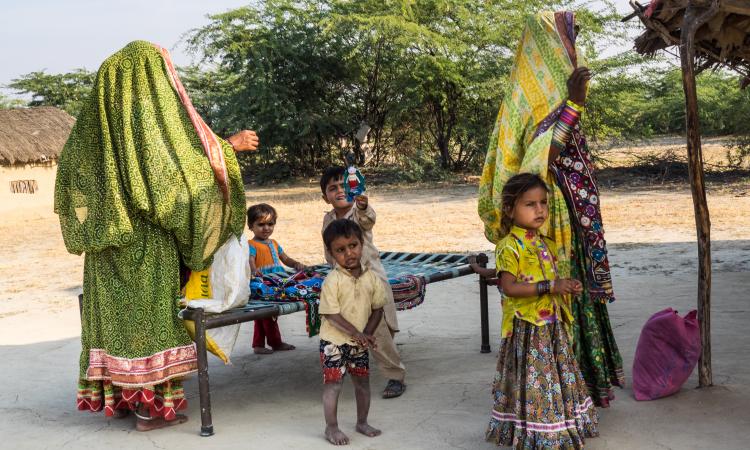
As per the Housing for All Plan of Action (HFAPoA) of Bhuj, prepared under the Pradhan Mantri Awas Yojna (PMAY) in 2018, out of a total of 13,978 households residing in slums in Bhuj, 83 percent (approximately 11,631) houses were owned and were sited on public land.
PMAY gives Rs. 3.5 lakhs of government assistance to the Economically Weaker Section (EWS), which has an annual household income of Rs. 3 lakhs. Here, the condition is that the piece of land should be in the applicant's name. In the case of Bhuj, 83 percent of households lack land entitlement as they live on public land.
In-situ slum redevelopment, another component of PMAY, is not viable due to G+2 height restrictions, as Kutch is categorised in Zone V in terms of seismic vulnerability, which is a very severe intensity zone for earthquakes. Therefore, private developers are not interested in investing in this component. The same issue lies with the Affordable Housing in Partnership (AHP) component of the PMAY.
Considering the technical glitches in availing benefits under the PMAY, the Zameen Ane Aawas Adhikar Manch (ZAAAM) was constituted and nurtured under the Homes in the City (HIC) programme, searching for a solution to address this blockage. They found the 2003 Revenue Department, Government Resolution (GR) of Government of Gujarat (GoG) No. JMN-392003-454-A dated June 6, 2003, which gives authority to the District Collector to allocate land to an individual up to 200 sq. m., having an annual income of Rs. 48,000. ZAAM disseminated awareness among slum dwellers about this resolution and encouraged them to apply for land allocation.
As a result, 58 families living over 30–40 years on public land belonging to the state and owned by the District Collector of Kutch applied for the land with all the necessary documents, paid the 1% of the Jantri price of the land, and wished to pay the remaining Jantri price of the land, in case land was allocated to them.
Most of the applications submitted in 2022 and 2023, were rejected by the Collector Office as their household income was above Rs. 48,000 per annum. “Most of the families have an annual income of Rs. 60,000–70,000. Rejecting these applications in 2023–24 based on the income criteria set in 2003 is invalid and does not provide justice to these families. Moreover, central government schemes such as PMAY, the National Food Security Act (NFSA), and Aayushmaan Bharat consider the Economically Weaker Section (EWS) up to Rs. 3 lakhs of annual income. It is not understood why this discrimination and inconsistency regarding the annual income criteria for an EWS family is prevalent among different government schemes,” said Minaxi Chouhan, convenor of ZAAAM.
“Therefore, a letter has been sent to the District Collector, copied to the Hon. Chief Minister of Gujarat, Additional Chief Secretary, and Chief Secretary of Gujarat in February 2024, to investigate the matter and revise the income slab considering other central and state government programmes and schemes as well as inflation in the last 20 years, so that these poor families can get land allocations that open access to the PMAY to build their houses,” she added.
On July 25, 2024, Karshan Hirjibhai Vaghela and Thakarsi Narshibhai Vaghela, residing at Juni Rawalwadi slum settlement, whose applications were rejected by the District Collector Office, visited the Statewide Attention on Grievances through Application of Technology (SWAGAT) Programme at Gandhinagar to update the income slabs in the 2003 GR and were given assurance that the CM office will look into this matter and do the needful.
The 2003 G.R. is a very progressive step by the state government, but it has not been executed in its true spirit to benefit the poor in small and medium-sized cities in Gujarat. It is the need of the hour to make essential upgradations in this G.R., considering the present socio-economic profile of the slum residents residing in small and medium-sized cities. The District Collectors should be directed to promptly act on the received application under the G.R. to facilitate the construction of dwelling units under ambitious PMAY.
This issue is a setback for the promise of Housing for All-2022 made by the present government due to poor execution of this G.R., whereas states like Odisha and Punjab have passed legislation to give lands to the poor and then linked them with the PMAY for the construction of their houses.
The inclusion of the poor in accessing public lands ensures equitable distribution of resources in the city, solves the problem of ghettoisation in cities, and makes our cities liveable for all, not just the rich.
Aseem Mishra is the Programme Director of the Homes in the City (HIC) programme in Bhuj, Kuchchh, Gujarat.
/articles/pmay-paradox-policy-gap-leaves-bhujs-poor-homeless